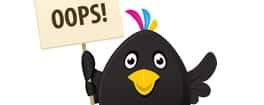Twitter Mistakes
With more than 200 million active users (and 500 million total accounts), Twitter bills itself as the “pulse of the planet.” Like any social media tool, it’s easy for businesses to do more harm than good for their brand image when using Twitter. From hashtag campaign disasters to insensitive automated tweets, here is what went wrong this year – and how to avoid repeating the same mistakes in 2013.
#1: Hashtag campaigns.
In Twitter’s vast microblogging community, hashtags collate ideas around a single thread, theoretically allowing businesses to better promote a product or service. In reality, the majority of hashtag campaigns run by major corporations backfire. Rather than boosting sales or enhancing brand image, the campaigns became a very public forum for customer complaints. For example, Starbuck’s UK customers used the company’s #SpreadTheCheer campaign to criticize Starbuck’s labor policy and corporate tax dodging, rather than tweeting about holiday plans, as the company had intended. Even worse, Starbucks prominently displayed the profanity-laced criticisms in real-time on a giant screen at a London holiday ice skating rink – much to the ire of families skating with young children.
Lesson learned: Just say no to hashtag campaigns. Twitter is a great forum for engaging customers and responding to complaints, but to do so successfully, companies must maintain control over their content. A hashtag campaign presents a huge challenge since it is impossible to respond to every negative tweet. Instead, hashtag campaigns open the floodgates for criticism – without providing an appropriate platform for prompt response.
#2: Poorly timed tweets.
The National Rifle Association’s pre-scheduled tweet struck a nerve following July’s Aurora, CO shooting. The message, scheduled in Hootsuite and tweeted the morning following the shooting, said, “Good morning, shooters. Happy Friday! Weekend plans?” The NRA later deleted the tweet and the account @NRA_Rifleman, but not before being blasted for the insensitive message. The controversy didn’t end there; CelebBoutique, an online fashion store, tweeted, “#Aurora is trending, clearly about our Kim K inspired Aurora dress”, followed by a link to purchase the dress. CelebBoutique’s insensitive message echoed a Kenneth Cole mistake from February 2011, when the retail company tweeted that the brand’s spring fashion line, rather than the Arab Spring, caused riots in Cairo, Egypt.
Lesson learned: Timing and context matter. Be careful when pre-scheduling social media messages – even innocuous ones can backfire. Short on time? Create a list of possible messages for Twitter, but post them in real-time rather than using an automated service. CelebBoutique blamed their non-US based PR team for the mistake, but that’s no excuse. Understand why a term is trending before tweeting about it.
#3: Confusing company and personal accounts.
Both Microsoft and Kitchen Aid barely dodged PR disasters when members of the companies’ respective social media teams tweeted using the official company handle, rather than their personal handles. Microsoft criticized conservative media pundit Ann Coulter, replying to a tweet from former U.S. Labor Secretary Robert Reich with the following: “@RBReich your granddaughter’s level of discourse and policy > those of Ann Coulter.” Kitchen Aid’s tweet, however, takes the cake. After President Obama mentioned his grandmother during the first televised debate, a Kitchen Aid spokesperson tweeted from the company handle, “Obamas gma even knew it was going 2 b bad! She died 3 days b4 he became president. #nbcpolitics.” Kitchen Aid issued a public apology.
Lesson learned: Private and professional account separation is PR 101. From major corporations to small businesses, account separation is an absolute must. Institute protocols to prevent tweeting mistakes and protect your corporate twitter account. Create a separate customer support account to manage complaints, technical problems and other customer service issues; this will keep the negative posts away from your official corporate account.
Think before you tweet.
The strategic use of social media is essential to successful marketing and search engine optimization. As digital media convergence increases social media’s importance, companies must understand how to use Twitter effectively to engage with customers and build brand loyalty. While it may take only seconds to fire off a tweet to thousands of followers, it can take weeks to clean up the PR mess. Avoiding PR mistakes starts with the simple adage: think before you tweet.
